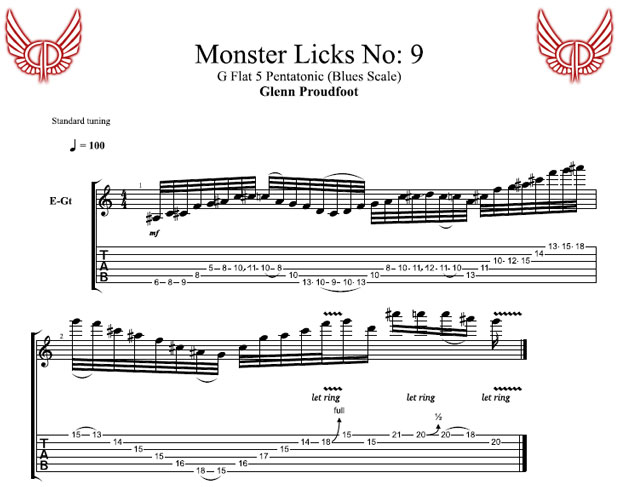Monster Licks: A Stroll Through the Pentatonic Scale's Rougher Neighborhood

For this Monster Lick, I'm using the G blues scale.
As I've stated in the past, the blues scale, when applied a certain way, can sound incredibly tough and can be used to add a darker side to your playing.
Because we generally approach the flat 5 or “blue note” as merely a passing note when we play blues or blues rock, the scale sounds incredibly smooth and even a little jazzy. My way of incorporating the flat into the licks and runs creates a slightly dissonant-sounding movement. The dissonance immediately creates the tension that often is needed when soloing to heavy, dark rock or blues-based rock.
Having said this, you must be careful how and where you use this approach or runs like this. There are times when it will be tonally fantastic and other times when it will be too dark-sounding for the piece of music. It is important to use your ears and not get too wrapped up in one particular sound or variation of the scale.
The Lick:
It is important to recognize the arpeggio shapes I'm creating here. The first shape starts on the ninth fret of the low E and finishes on the fifth fret of the D string. The next one starts on the eighth fret of the D string, finishing on the 13th fret of the low E, and so on. (When you are looking at the tab below, you can easily identify the arpeggios; they run diagonally and down/up the transcript, reading from left to right.)
In order to get the lick up to speed, you have to finger these arpeggios so quickly that you need to be poised and in position, as you would be when you're about to change a chord in your rhythm playing.
All the latest guitar news, interviews, lessons, reviews, deals and more, direct to your inbox!
While practicing this, never approach the arpeggios in a lazy fashion, with all your fingers on the notes already, and then simply strum. All the notes will bleed into each other and create a sonic mess. Your hand must be poised and ready for action. Knowing the shapes will give you the advantage of playing quicker and cleaner.
The other key to this lick is the transitions between the arpeggios. The transitions consist of picked notes, slides and legato. The first note of these single lines is always the last note of the previous arpeggio. I suggest focusing on the first transition line as the patterns remain constant throughout the lick. Once understood in the first position, the rest will flow easily.
I hope you enjoy it! Please join me on YouTube right here! Or contact me at glennproudfoot.com or my Facebook page.

Australia's Glenn Proudfoot has played and toured with major signed bands and artists in Europe and Australia, including progressive rockers Prazsky Vyber. Glenn released his first instrumental solo album, Lick Em, in 2010. It is available on iTunes and at glennproudfoot.com.

